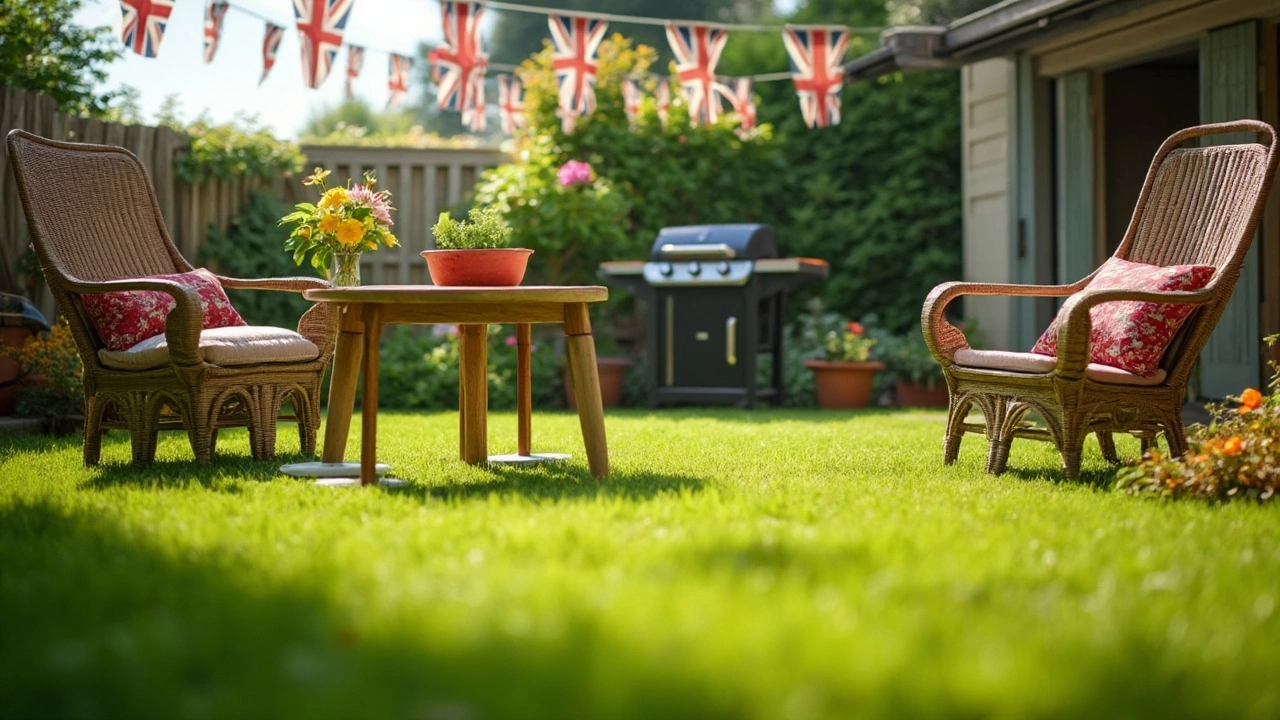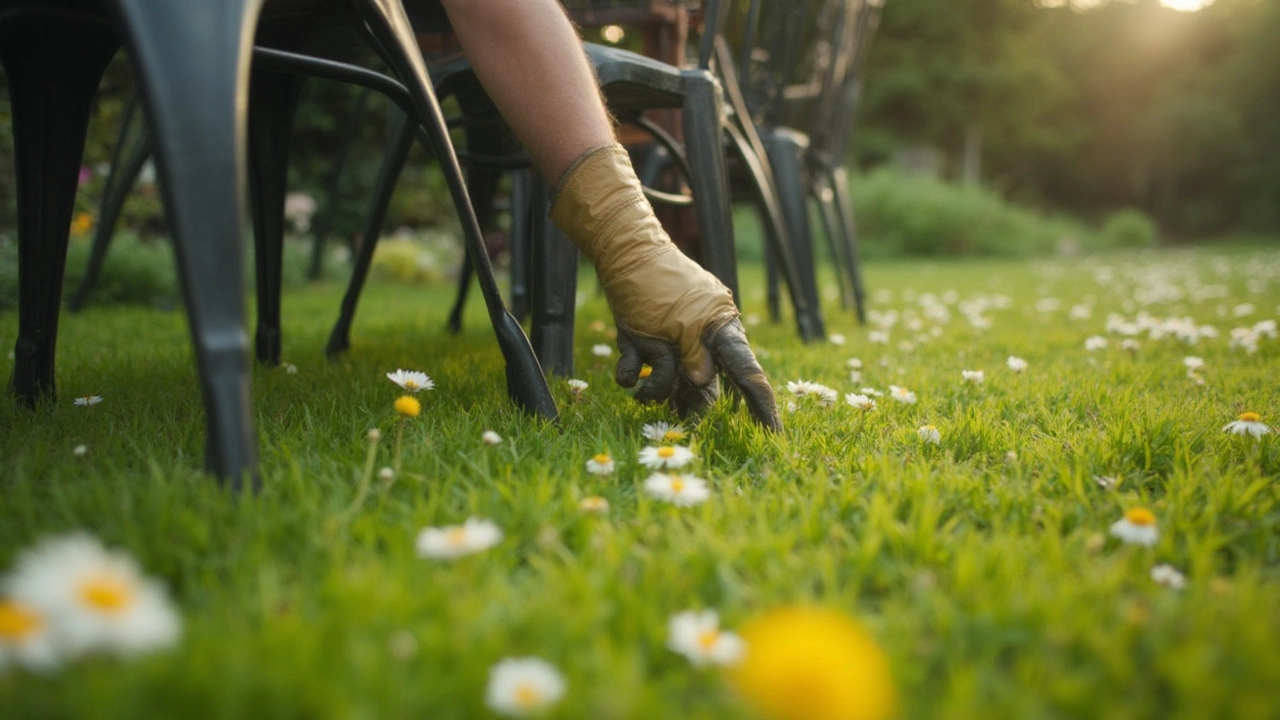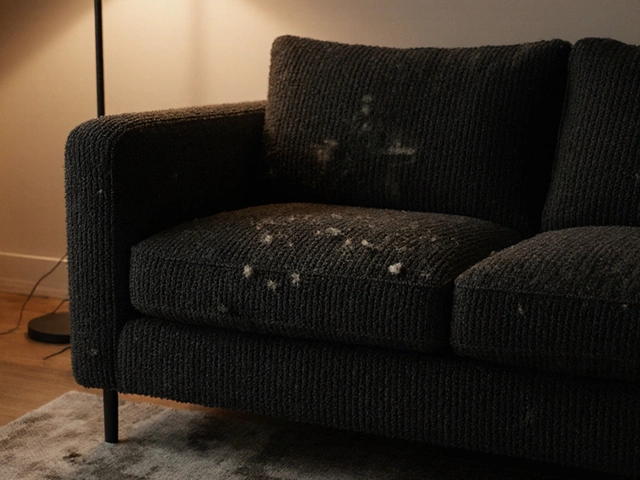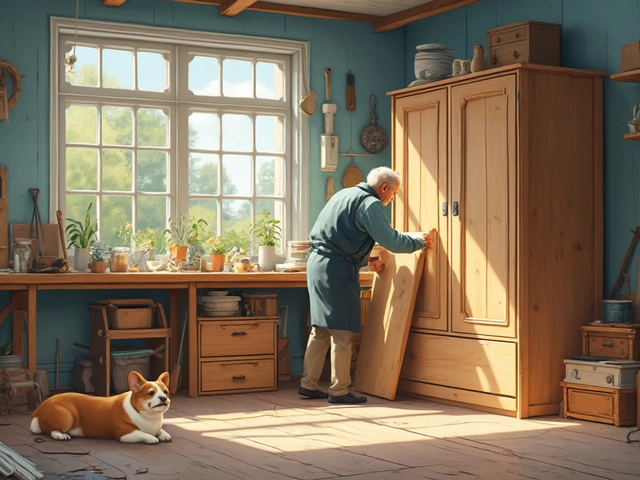 4
Jun,2025
4
Jun,2025
Nothing ruins a chill afternoon in the backyard faster than a wobbly chair leg poking straight through the grass. If your outdoor furniture keeps leaving embarrassing dents or sinking slowly every time you sit, you’re not alone. Grass just isn’t built to handle those tiny legs and all that weight—especially after it rains or when the lawn is a bit soft.
But you don’t have to give up on lounging outside or break the bank for a new patio. There are surprisingly simple ways to stop the problem right now. No need for fancy gadgets or calling in a pro. With a few common materials and a couple of small changes, you’ll have steady, even seating and a lawn that still looks great.
Ready to make your backyard as comfy as your living room? Let’s get into the tricks that actually work, and why your lawn is getting squished in the first place.
- Why Does Garden Furniture Sink?
- Quick Fixes for Immediate Relief
- Smart Underlay Solutions
- DIY Sturdy Surfaces
- Long-Term Lawn Protection
- Maintenance Tips for Lasting Results
Why Does Garden Furniture Sink?
Most backyard furniture isn’t designed with your lawn in mind. The basic problem is weight being jammed into a small space. Furniture legs, especially the thin ones, turn into little spikes when you sit down. They push all that force straight into the grass and the dirt below.
Let’s talk numbers for a sec. The average garden chair with a person sitting on it can easily load each leg with more than 40 pounds (about 18 kg). Multiply that by four legs and light soil just gives way. Throw in some rain or overwatering and your lawn becomes a cushion—one that fades fast under pressure.
Here’s a quick breakdown of what’s working against you:
- Garden furniture legs usually have a small surface area, so all the weight presses down in one tiny spot.
- Wet or recently watered grass makes the ground even softer and more likely to give way.
- Certain garden soils (like clay) hold water longer and can stay muddy for days.
- Heavy furniture, or more people, means deeper dents and more squishing.
This is why some lawns look bumpy after just one outdoor party. The ground needs to be firm enough to resist all that poking, but grass and soil work differently than a patio. Even grass that looks healthy isn’t immune, especially when there’s been rain in the last 24 hours.
| Condition | How Fast Furniture Sinks |
|---|---|
| Dry, compacted soil | Slow |
| Wet, clay-heavy soil | Very fast |
| Freshly laid turf | Extremely fast |
| Thin furniture legs | Faster |
| Wide furniture legs (pads attached) | Slower |
So, if you find dents in your grass after sitting outside, it’s not just bad luck. It’s a mix of soft ground, skinny furniture legs, and the unavoidable force of gravity. But you’re not stuck with soggy seats or sunken tables—there are ways to fix this, and it starts by tackling the problem at the ground up.
Quick Fixes for Immediate Relief
If your garden furniture constantly sinks into the lawn, you probably just want a fix that works today—not next week. Some hacks can hold you over until you decide on a long-term solution, and you can pull them off with stuff you likely already have at home.
First, try spreading out the weight under each leg. The thinner the furniture legs, the more likely they'll dig into the ground. The trick is to increase the surface area so the pressure gets spread out. Here’s how:
- Coasters or Old Tiles: Slip basic drink coasters or some spare ceramic tiles under each furniture leg. Even plastic lids from peanut butter jars or large bottle caps work for lightweight chairs.
- Wooden Offcuts: If you’ve got some old pieces of wood or planks, cut them down to a size just a bit larger than the base of your furniture legs. Set the legs right on top for quick support.
- Rubber Mats: A heavy-duty doormat or a piece of rubber matting can be cut up and put underneath. These are useful for making your setup less slippery than tiles or plastic.
For picnic tables or heavier pieces, try laying down a longer plank or board so the weight gets shared across more grass. If you're expecting guests or just a sudden urge to throw a BBQ, these quick fixes can save your lawn (and your dignity) when someone sits down.
Still curious how much weight your grass can handle? Here’s a quick breakdown of what most standard lawns can take before getting dented:
| Grass Condition | Weight Supported per Square Inch | Notes |
|---|---|---|
| Dry, well-established | 15-20 lbs | No lasting marks unless leg is sharp or thin |
| Moist after rain | 5-8 lbs | Dents easily, slow to recover |
| Heavily shaded/lush | 10-12 lbs | Moderate risk of sinking, especially with repeated use |
Another fast trick? Set the furniture on areas with thicker, tougher grass. Avoid freshly seeded or patchy spots—they’re just asking for trouble. These fixes aren’t fancy, but your backyard will thank you. Now your only worry is who gets the last burger at the table, not the embarrassing chair-dive into the lawn.
Smart Underlay Solutions
The trick to stopping garden furniture from sinking is spreading out the weight. A narrow chair leg on soft grass is like a stiletto heel at a picnic—bad news for your lawn. That's why smart underlay solutions make such a difference. They're simple, cheap, and don’t mess up the yard’s vibe.
The fastest fix? Use wide, flat objects under the legs. Think paving slabs, rubber mats, or even those big plastic furniture feet from the hardware store. The wider the base, the less likely your chairs and tables are to leave marks or disappear into the earth. For a picnic table or heavy bench, try plastic decking tiles. They snap together and sit perfectly on top of grass, making your setup feel rock solid.
Some folks get creative and use old tiles, wood offcuts, or thick outdoor coasters under their chair legs. Just make sure the stuff you use doesn’t rot or soak up water—wet wood can get gross fast. If you want a neater look, you can actually buy sets of furniture pads made specifically for outdoor use. These usually snap or stick onto the bottom of the legs and come in all shapes and sizes.
- Concrete pavers are tough and don't shift, but they’re heavy if you move furniture often.
- Rubber mats (recycled ones made for playgrounds are perfect) add grip so nothing slides.
- Plastic foot pads are lightweight and easy to pop on and off as needed.
- Deck tiles look tidy and are easy to store away at the end of the season.
Wondering which is best for your backyard? Here’s a quick breakdown you can use when picking your underlay fix:
| Underlay Type | Cost | Durability | Setup Ease | Good for |
|---|---|---|---|---|
| Paving Slabs | Medium | Excellent | Medium | Permanent setups |
| Rubber Mats | Low to Medium | High | Easy | Kids' areas, moveable furniture |
| Plastic Deck Tiles | Medium | Medium | Easy | Entertaining, picnic tables |
| Furniture Foot Pads | Low | Medium | Very Easy | Lightweight chairs |
All of these options not only protect the grass but also make your garden furniture last way longer. No more rusty chair legs or surprise faceplants when you plop down. Keep these hacks up your sleeve and your backyard will stay tidy no matter how many guests you invite over.

DIY Sturdy Surfaces
If you’re sick of those chair legs digging into the lawn, building a solid base area is the way to go. You don’t need a pro-level workshop to set it up—just a little effort and some wallet-friendly materials you can grab from any home store.
The most common move is plywood. Grab a thick piece (at least 18mm, or about 3/4 inch), cut it to the size of your garden furniture set, and lay it right under the legs. It spreads out the weight, which keeps the legs from punching holes through your grass. Just remember, untreated plywood can soak up water and rot fast, so slap on a coat of waterproof sealant before you use it outside.
If you want a cleaner look, interlocking deck tiles are awesome. They’re easy to snap together, come in plastic or wood, and you can cover any area you want—plus, you can lift and store them for winter. For something rock-solid and lasting, concrete patio slabs or pavers do the trick, though dropping them into place is a bit heavier work. The trick here is to make sure the ground underneath is level, or your furniture still ends up wobbly.
- Pallet wood platforms: Free if you can snag a used pallet. Sand it, seal it, and place furniture directly on top.
- Rubber pads or mats: Weatherproof and soft on your lawn; they’re also cheap and keep things steady even after rain.
- Old carpet tiles: Great for parties or quick fixes. Set the tiles under each leg to spread out the pressure and avoid dents.
Here’s how some quick-and-easy surface solutions stack up for the average backyard user:
| Surface Type | Setup Time | Weather Resistance | Estimated Cost | Reusability |
|---|---|---|---|---|
| Plywood Board | 10-15 minutes | Moderate with sealant | $15-$30 | 1-2 seasons |
| Deck Tiles (Plastic/Wood) | 15-20 minutes | High | $30-$60 | Multiple years |
| Concrete Patio Slabs | 30+ minutes | Excellent | $3-$8 per slab | Permanent |
| Rubber Mats | 5 minutes | High | $10-$40 | Multiple years |
| Carpet Tiles | 5 minutes | Low | $1-$5 per tile | Temporary |
If you want your outdoor space looking good and staying firm underfoot, this hands-on approach is hard to beat. You get fewer muddy patches, less hassle leveling furniture, and it’s easy to switch things up whenever you want to move stuff around or pack up for the season.
Long-Term Lawn Protection
If you’re tired of wrestling with sunken chairs every summer, it’s time to think bigger: let’s make sure your lawn can handle garden furniture for the long haul. The trick isn’t just about supporting the furniture, but building up your grass so it bounces back faster and stands up better to weight. Healthy, dense grass really does make a difference. According to the Royal Horticultural Society, “Regular mowing, aeration, and feeding will help toughen up your lawn and prevent lasting marks from garden furniture.”
"A well-fed, well-maintained lawn is much more resilient to occasional pressure from family activities or outdoor furniture." — Royal Horticultural Society
So, what bumps your lawn from average to heavy-duty? Here’s where you want to put your focus:
- Regular Aeration: Poking holes in the grass, either with a garden fork or a rolling aerator, helps roots grow deeper and makes the lawn less squishy. Aim to aerate in early spring and again in fall.
- Feeding the Grass: Apply a slow-release lawn fertilizer two or three times a year. Well-fed grass thickens up, spreads out, and holds firm under outdoor seating.
- Choose Furniture Wisely: Lighter pieces with wide legs or feet are less likely to sink. Stay away from thin metal or plastic legs—they’re lawn killers.
- Rotate Placement: Don’t leave your garden furniture in the same spot all season. Move it around to spread out the stress, especially after a party or heavy rainfall.
- Level and Fill: For any spots that have already caved in, fill them with a mix of topsoil and grass seed. Pat it down and water it. That’ll patch things up before they get worse.
Here’s a simple table showing how these actions impact your lawn’s strength against sinking furniture:
| Action | Improvement to Lawn Resilience |
|---|---|
| Aerate 2x a year | Up to 40% less soil compaction |
| Fertilize regularly | 30% thicker grass coverage after one season |
| Move furniture monthly | Prevents dead patches, spreads wear evenly |
| Refill sunken spots annually | Repairs damage before it gets out of hand |
None of these steps are complicated. It’s all about regular care and a few tweaks to your routine. Stick with it and you can finally say goodbye to wobbly garden chairs and unsightly ruts in your grass.
Maintenance Tips for Lasting Results
If you want to keep your garden furniture from sinking and your lawn looking fresh, a little upkeep makes all the difference. Most outdoor fixes don’t last long if you forget to check in every now and then. The good news? These routines are quick and mostly painless.
First up, move your chairs and tables around now and then. Leaving heavy furniture in the same spot for weeks creates permanent dents, especially after rain. Just rotating furniture once a month can stop ground compaction in its tracks.
After big storms or watering, check the grass under your furniture. Soft, muddy spots are your worst enemy. If you spot any, lift the furniture for a day or two to let the ground dry. This quick break helps the soil bounce back.
Don’t forget about the bottom of your furniture legs. Gunk and mud build up over time, which makes them push in deeper. Wipe them off every week or two. For extra cushioning, make sure any pads or coasters underneath are clean and not broken down.
- Give the lawn a simple aeration in spring and fall. It’s just poking decent-sized holes in the ground to help with drainage and keep the grass roots strong.
- If you use mats, boards, or patio slabs under your furniture, inspect for cracks or wear at least every season. Replace anything that’s getting soft or misshapen.
- Keep the grass healthy by mowing regularly and not too short. Taller grass (about 2.5 inches) is tougher and holds up better under stress from furniture.
- Fertilize your lawn two to four times a year, depending on your local weather. Well-fed grass stands up to weight much better.
If you want a quick comparison on how often to tackle these tasks, check this breakdown:
| Task | How Often? |
|---|---|
| Move Furniture | Monthly |
| Clean Furniture Legs/Pads | Bi-weekly |
| Aerate Lawn | Twice a Year |
| Inspect Underlays | Seasonally |
| Mow Grass | Weekly (in growing season) |
| Fertilize Lawn | 2-4 Times a Year |
Stick to these habits, and your outdoor space stays inviting, sturdy, and easy on the eyes. It’s a small effort that saves you from fixing sunken spots or patching up your lawn all summer long.




